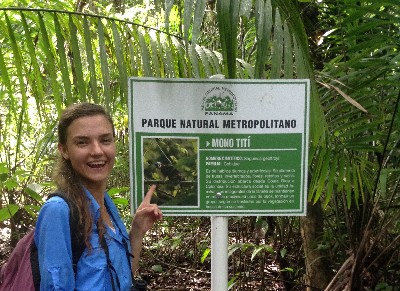Studying Panama's Geoffroy's tamarin

Caitlin McNaughton, a 21-year old Zoology and Environmental Studies student from Ohio Wesleyan University, is in Panama studying the Geoffroy's tamarin (Saguinus geoffroyi). The Geoffroy's tamarin is also called a Tití monkey here in Panama.
Caitlin’s project is part of an International Training's program in Tropical Ecology, Marine Ecosystems, and Biodiversity Conservation. While in Panama, with the support of Concervacion Panama, Caitlin will collect data on the Tití monkey’s population, demographics, and territory sizes.
Caitlin chose to study Panama’s Tití monkey as her Independent Research Project (ISP) for a couple of reasons. First, because the program presented an opportunity for her to improve her Spanish, and also because it allowed her pursue a field biology project totally of her choosing. Furthermore, not only is there relatively little literature available about the species primarily found in Panama, these little guys are relatively accessible here! Tití monkeys can be commonly seen in Panama City's Parque Natural Metropolitano.
"It was with the guidance of my research advisor, Ezekiel (Zeke) Jakub (Vice President of Conservacion Panama) that I discovered Panama City's Parque Natural Metropolitano, which is both accessible and full of more species than I could have imagined, ” explained Caitlin. The Metropark is a protected park in Panama City and home to a large variety of birds, insects, amphibians and mammals. With support from the park’s director Caitlin was able get started collecting data at the beginning of November.
One of the interesting topics Caitlin is studying are the threats Tití monkeys living in park may face. “The park is part of a biological corridor including Soberania and Camino de Cruces National Parks, but is otherwise surrounded by city, making it a semi-urban habitat,” explains Caitlin. “Because of the levels of human activity within and surrounding their habitat, especially roads the landscape that been impacted by humans, we would expect to see more less habitat available for use by the monkeys.”
While Tití monkeys pretty tolerant of habitat disturbance, Caitlin aims to find out how living within a metropolitan park might impact the territorial species. To find this out Caitlin wakes up early each morning (when the monkeys are most active) to walk the trails and map the tamarin's locations. By counting the numbers and relative ages of individuals in each group, and noting their behavior, she is able to develop patterns and map repeat behavior. Currently Caitlin is in the data analysis phase, putting together all of the information collected so far.
Caitlin’s finding will offer insight into how the monkeys behavior may differ based on their semi-urban habitat, and what that behavior means. For example, Caitlin has observed that the Tití monkeys are tolerant of a close proximity to humans, hold relatively flexible diets, and are willing to cross roads using overhanging trees. Caitlin explains that the significance of this data, is that it could mean factors like people using the trails, area maintenance, or busy surrounding roads, among other things will not keep the monkeys from being successful.
Dispite the Tití monkeys tolerance to human activity, they face a variety to threats in the park and throughout Panama. One of their main threats is capture for pet trade. Their numbers may also be declining due to habitat loss. Looking specifically at monkeys living in the park is the biggest issue is likely the park's connectivity to larger areas.
“The Tití monkeys do cross roads, but further study would be necessary to find out exactly how often and where this movement occurs.” Explains Caitlin, “While the Metropark intends to a connect Panama’s major National Parks acting as a corridor, little is known about the monkey's population across the area.” Caitlin believes that connectivity is one of the key factors to maintain healthy populations of Tití monkeys in the park. To keep the parks connected, at least from the monkeys stand point, it is vital to retain enough trees, as this is how monkeys get from place to place.
“Since Tití monkeys live in groups, are territorial, and rely on a number of food sources which vary in availability, it is important that they are able to establish sufficient territory to fulfill their needs.” Since not all of the area surrounding the park is suitable Tití monkey habitat, connectivity to suitable areas is essential.
Upon arriving back in the states Caitlin will compare her observations of Tití monkeys here in Panama with groups of marmosets documented elsewhere. The study will offer insight into the species specifically the population living in the park.
Once Caitlin’s findings are complete, she hopes to share the information with the park. For and update on Caitlin’s findings check Conservacion Panama's facebook page.
Protection of Tití monkeys in Panama
These small primates are protected by law in Panama. While they are present in a number of protected areas throughout Panama, they can also be found in backyards, trees surrounding agricultural areas, and unprotected forest areas.
Trending Tags
